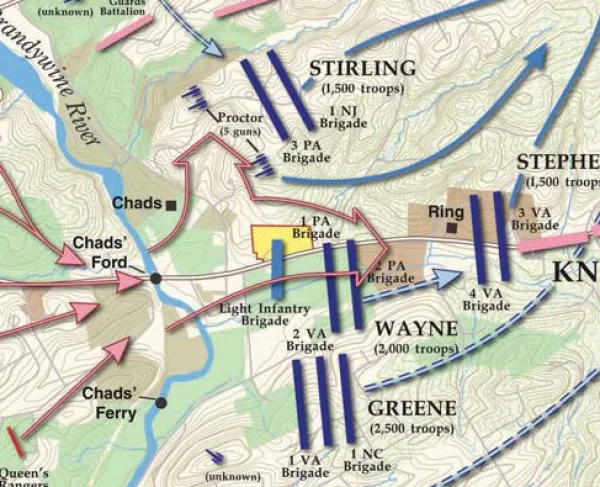
Brandywine Battlefield, Chadds Ford, Pa.
Help Save Hallowed Ground at Three Nation-Defining Battlefield Sites
The Opportunity
We have the opportunity to buy three tracts for a total of 158 acres of battlefield land from the Revolutionary War and the War of 1812. It’s a rare opportunity to save land from these first battles on American soil and we must seize it.
The total value for these tracts is a whopping $4.8 million! Thanks to matched funds from generous individuals along with anticipated grants from federal, state, and local entities, the Trust only needs to raise $201,500 to secure these properties.
Please donate today to save battlefield land at two revolutionary war sites and one War of 1821 site. Any amount you can donate to this effort will be matched $23.80 to $1. This means that for every dollar you donate, it will be worth $23.80 toward the value of preserving these battlefields forever.
The History
Battle of Brandywine, Pennsylvania
The first tract is 15 acres at Brandywine.
The Battle of Brandywine was fought on September 11, 1777, and did not go well for the Continental Army. The battle was massive, involving almost 30,000 troops, more than any other battles in the war. It raged for 11 hours, making it the longest single-day battle of the American Revolution. It covered ten square miles, more ground than any other battle of the war.
British Major General Sir William Howe and his subordinate Lord Charles Cornwallis squared off against General George Washington, Major General Nathanael Greene, General “Mad Anthony” Wayne, and the Marquis de Lafayette on the American side.
Washington was determined to prevent Sir William Howe and his army of 15,500 British Regulars and Hessian troops from capturing the American seat of government in Philadelphia. Taking up positions along Brandywine Creek, Washington believed that his army blocked all fords across the creek. He was mistaken.
Under the cover of heavy fog, General Wilhelm von Knyphausen positioned his forces at Chadds Ford, while the bulk of Howe’s troops crossed the Brandywine further upstream.
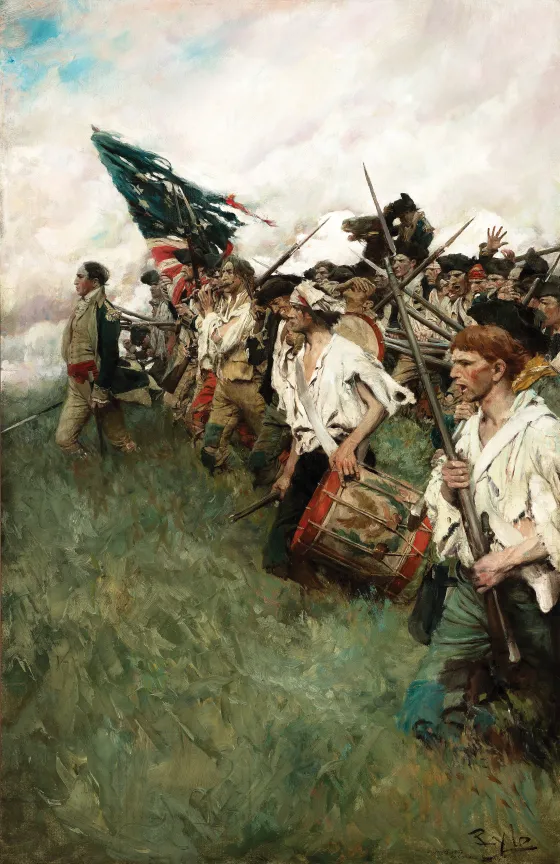
The battle had been raging for hours by the time Howe’s force appeared undetected on the Continental right flank. Washington furiously dispatched troops to the threatened sector, but despite a stiff resistance, the Continentals were eventually overrun by Howe’s men.
To prevent the defeat from turning into a disaster, Washington ordered Nathanael Greene’s division to act as a rearguard so that the Continental Army could escape to the northeast. Greene’s brave men counterattacked along the crest of Birmingham Hill. When night fell, the remaining Americans fell back in an orderly retreat, led in part by the Marquis de Lafayette.
The Americans suffered 1,300 casualties in a crushing defeat that allowed the British to occupy Philadelphia. The overall outcome, however, was not nearly as bleak. The Battle of Brandywine was the first time the Continentals proved they could stand toe-to-toe with the most powerful fighting force in the world.
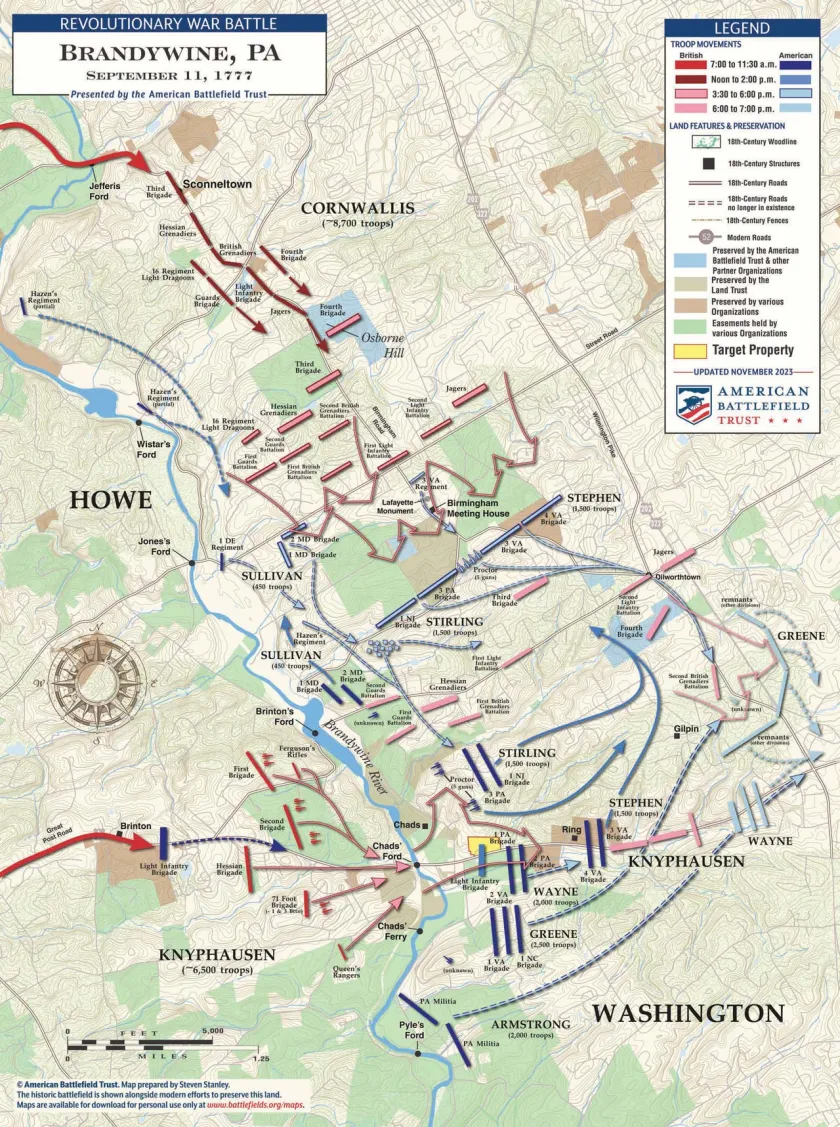
Preserving hallowed ground at Brandywine is no small feat. Though 187 acres of this battlefield have already been preserved, its proximity to Philadelphia is what made it so important in 1777, and so expensive today. Our target acquisition is 15 acres of a critical piece of the battlefield, as it is the center of Washington’s main defensive line at Chadds Ford.
Battle of Newtown, New York
The second tract we hope to preserve is 55 acres at the Battle of Newtown, New York.
The lead-up to the Battle of Newtown marked a violent epoch during the Revolutionary War. The Haudenosaunee (Iroquois), Six Nations, and their allies had decided to side with the British based on a weak foundation of promises and continued to defend their land against New York and Pennsylvania settlers. These actions diverted manpower from the Continental Army, stripped the settlers of their food supplies, and spread terror throughout settlements. They had to be stopped.
In 1779, General George Washington allocated a force of 4,000 troops to General John Sullivan with orders to subdue the Haudenosaunee (Iroquois), Six Nations. Sullivan and his forces moved into upstate New York with the objective of destroying crops, crushing their morale, and temporarily removing them as a threat to the rebellion.
Finally, on August 29, 1779, the fleeing Haudenosaunee (Iroquois), Six Nations, stood their ground. They were joined by a group of about 200 Loyalist militia members under the command of John Butler and set up to ambush the Continentals along the banks of the Chemung River.
The Haudenosaunee (Iroquois), Six Nations plan, however, was detected by Sullivan’s scouts, and rather than marching into an ambush, the American troops conducted a wide-ranging flanking maneuver across the very tract we’re hoping to save. The objective was to surround the British allied forces and deliver them a devastating defeat. Sullivan succeeded in driving off the mixed force of Loyalists and Haudenosaunee (Iroquois), Six Nations, but he failed to encircle and destroy his adversaries. While the Southern colonies became the focus of the British high command between 1779 and 1781, Sullivan’s campaign marked a Patriot success in the vital Northern Theater of the war.
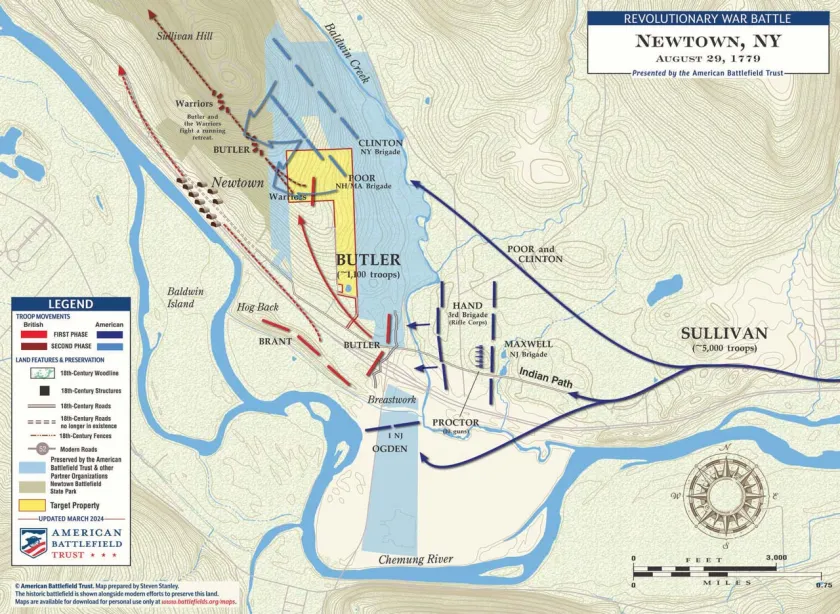
The 55-acre tract is a critical parcel that will connect and enhance previously acquired property. In the past two years, the Trust – thanks to good members like you – has made incredible progress in preserving the battlefield of Newtown. If we’re able to add this tract to the land saved, the Trust will have more than doubled the size of the existing Newtown Battlefield State Park.
Battle of Sackets Harbor, New York
The third tract we have an opportunity to save is 88 acres at Sackets Harbor, New York, on Lake Ontario.
When the War of 1812 broke out between Britain and the United States, both sides began building up their naval forces on the Great Lakes. The lakes were vital highways for troops and supplies, and a naval arms race quickly overtook the region.
The race was at a stalemate when the Americans decided to attack a British shipyard at the small town of York (now Toronto). The British, now believing it to be vulnerable, launched their own raid on Sackets Harbor — the main US shipyard on Lake Ontario. Its capture would give the British strategic control of both Lakes Ontario and Erie and relieve the pressure of the American land offensive directed against Upper Canada.
General Sir George Prevost, Governor General of Canada, personally took command of the raiding party. He hastily assembled a half-dozen ships, 900 British and Canadian soldiers, and a small party of Native American warriors and began landing soldiers at Sackets Harbor on May 29, 1813.
The Americans were ready for the attack, but when Prevost and his forces landed on Horse Island, the outnumbered militia troops awaiting them retreated across the causeway that connected to the mainland. The British and Canadians followed the Americans in hot pursuit, who retreated in disorder through the woods to an area south of the village.
All seemed lost for the Americans, but in time, General Jacob Brown of the New York militia, the senior American officer present, was able to rally the panicked militiamen, and ordered them to flank the British forces.
Concluding that his force could neither win a decisive victory before sunset nor hold the ground gained, and fearing that his retreat would be cut off, Prevost called off the attack and ordered his men back to the boats.
It was a victory, albeit a close one, for the American forces, who were able to maintain their stronghold on Lake Ontario.
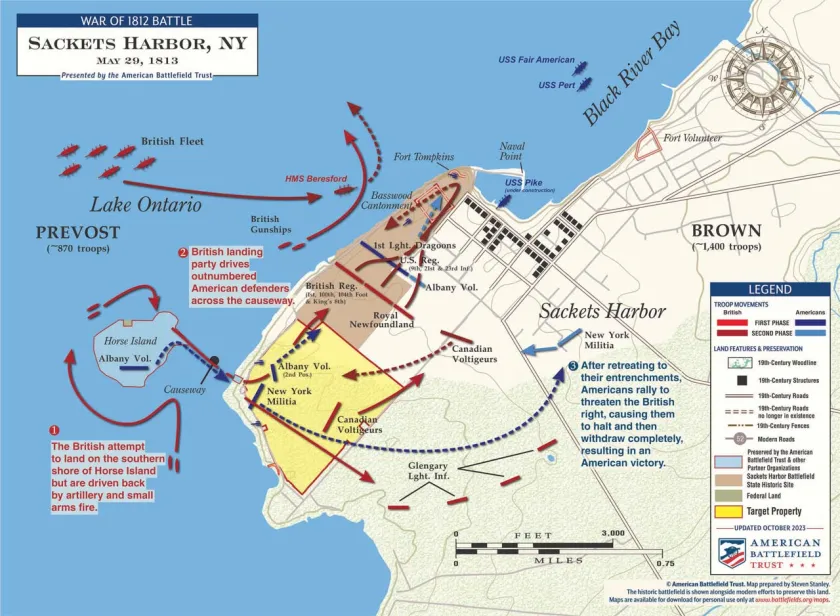
The 88 acres of battlefield land at Sackets Harbor provides an important connection to key points of the New York State Historic Site. It virtually completes the waterfront! It’s also where the causeway from Horse Island connects with the mainland.
Help Save Three Remarkable Battlefield Sites
Help us raise $201,500 to save three remarkable battlefield sites from the Revolutionary War and the War of 1812. Remember, every dollar you donate to this cause will be matched $23.80 to $1!
Plus – if you can give $50 or more today, you will receive a copy of the Trust’s Battle Maps of the American Revolution.
